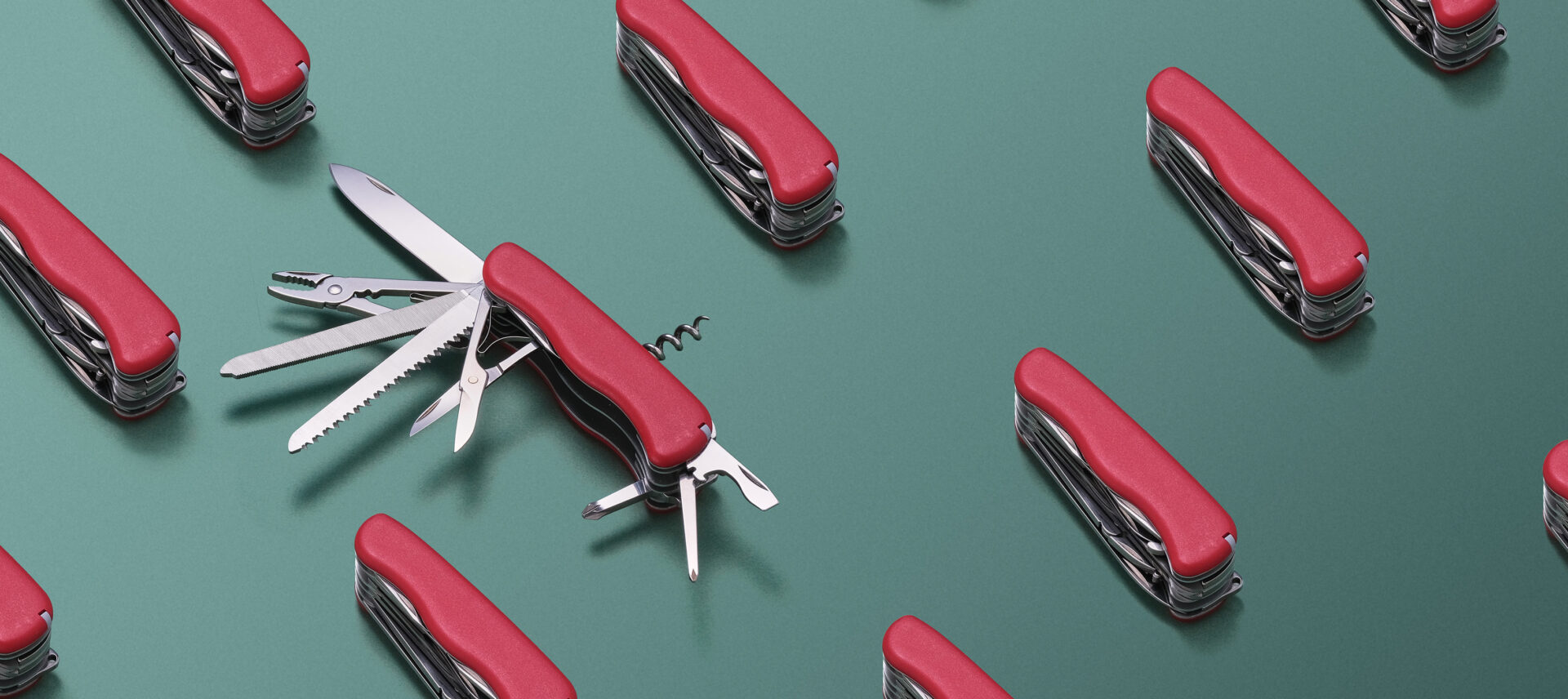
Article
Is the Myth of Universal Design Keeping You From Creating a Product Users Will Love?
Although universal design seems like a win/win, who really benefits? Learn how it’s actually hindering your product development and what to focus on instead.
It’s true in life and it’s true in product development: You can’t please everyone all the time. And sometimes the more companies try to make their product appeal to the masses, the less likely it is to resonate with anyone.
Are you limiting your product’s potential by trying to make it do too much to serve the needs of everyone?
You may be experiencing significant pressure from internal stakeholders to create universal designs that broaden your product’s market potential. But this pressure is based on the false assumption that the more problems you can solve in a single product, the better.
Chances are, your next product would benefit from a narrower scope than your well-meaning stakeholders are pushing for.
What Does Universal Design Mean in Product Development According to Me?
When people think about universal design, accessibility, and inclusivity are often the first ideals that come to mind. In fact, many people think universal design and accessibility are synonymous.
They’re not.
To be clear, we would never argue against making your product as accessible and inclusive as possible for your various user personas.
Your product can be accessible, inclusive, usable, convenient, and a pleasure to use and still not ultimately serve or benefit your users. For that reason, universal design isn’t the gold standard so many teams assume it is.
What’s Your Product’s Why?
Products that are carefully crafted to meet very specific needs are often more profitable than their universal counterparts. And no wonder. Most people would rather use a product that does its job extremely well (like an Xacto Knife) than one that does many things poorly (like a Swiss Army Knife). A spork was a clever execution of meeting multiple needs for a utensil, but in sacrifice, it never meets any of them well. It’s neither better than a spoon and nor better than a fork.
Of course, there’s a balance to strike here. Think about kitchen gadgets. Some uni-taskers just take up precious counter space and should never have been made to begin with! Case in point: does anyone really need a six-wedge quesadilla maker?
But more often than not, it’s the “this tool does everything!” multi-taskers that are the most egregious offenders. For instance, food choppers that come with a different blade for every possible kind of food sound great on the surface. But they’re a nightmare to clean, and they don’t produce a consistent, predictable result. For speed and precision, a sharp, high-quality knife is the tool of choice for discerning cooks.
If you want to stand out in your market, your product needs to do something extremely well. That might mean breaking away from what your competition is doing to appeal to an entirely different audience. Or it might mean crafting a thoughtful product development roadmap that includes plans to release multiple versions of a product to meet the particular needs of different users.
2 Ways To Maximize Your Product’s Market Potential
So, how do you create an innovative new product that delivers the market edge you’re looking for? It starts where every successful product begins — with a robust research and strategy phase.
1. Do VOC Research With More Than the “Average” User
The best products aren’t dreamed up within the confines of a boardroom. They’re born out of insights that come directly from your users. That’s why it’s so important to begin the product development process by doing your research and doing it thoroughly.
We find it particularly impactful to spend time with users who might conventionally be seen as outliers. We especially love talking to:
- Power users who understand the problems we’re trying to solve better than we do (and who may have developed creative workarounds to the problem at hand).
- Occasional users who don’t know the product like the back of their hand (watching how they approach the problem can quickly elevate usability issues or challenges).
- Users with disabilities or different abilities (so we don’t overlook a single accessibility need).
- Negative Nancys who have nothing good to say about the mock-ups and prototypes we put in front of them (constructive criticism is almost always more instructive than easy praise).
If you can’t talk directly to users like these, do an in-depth thought experiment. As an exercise with your development team, consider the non-average user and brainstorm how you might shift your approach to satisfy them. What might your product look like if you design it for one specific kind of user? Would it cause a paradigm shift in your market? Would your typical user also benefit from the design?
After exploring these questions, you might find a new market opportunity you can’t afford to pass on. Or you may still decide that a mass market approach is the best bet for your product right now.
Either way, you can move forward with confidence knowing you’ve dealt with any potential blind spots that would otherwise hinder your product’s current and future potential.
2. Don’t Be Afraid To Make Tough Design Decisions
Product development teams tend to default to universal design principles for one of two reasons. They either don’t know how to navigate stakeholder conflict or they think they’re de-risking the product development process by broadening their concept’s reach.
We get it. Internal conflict can be tense and unpleasant, and risk is scary. But as a design leader, it’s your job to move past these obstacles.
First, understand that it’s actually riskier to create a product without a clear purpose than it is to develop one that thoughtfully reaches your users where they are. And second, identify your product’s success drivers and prioritize them appropriately. Ask yourself:
- What are the high-level concepts and guiding principles that ensure our product furthers our business objectives?
- And what do users truly want from our product?
Once your team is aligned around success drivers, they’ll typically be more open to leaving ideas and concepts on the table. For example, when designing a user interface for a recent product, the original goal was to use universally recognizable icons to simplify global inventory. After beginning user testing, however, we quickly realized that this would lead to a continuous cycle of benefitting one user group but confusing another. We were trying to use icons that mimicked a media player to communicate certain functionalities to users. While this approach resonated with younger generations, it was hit-and-miss for older generations. After taking a step back and re-evaluating our success drivers, we ultimately realized that, given the importance of this device in emergency situations, we needed to take an approach that paired English text along with the icons. This of course meant that the product would not be globally understood, but making that tradeoff was critical to ensuring the product could do its job well.
This example is just one of the many that we sometimes face when trying to take a universal approach in the product development process, and each one has its own nuances. Sometimes a universal approach adds more complexity without providing the cost benefit to the user, sometimes it may overcomplicate the product making it cumbersome to use, and other times it may lead to a product that doesn’t meet any user needs well enough to be useful.
As long as you’re aware of what you’re leaving on the table, it’s all good. Be sure to keep track of the elements you choose not to include and consider whether it makes sense to incorporate them in the future. You might be able to use those rejected concepts in a specialized product for an untapped segment of your market.
There’s No One-Size-Fits-All in Product Development
It’s fine to try to appeal to as many users as possible. But you shouldn’t do so at the expense of your product’s overall purpose.
So find your product’s why. Identify the elements that will lead to true market success. Talk to the users who will help you tailor your product to marketable wants and needs. And don’t be afraid to make the tough decisions that lead to a superior solution.
Need some help along the way? Don’t hesitate to reach out.





